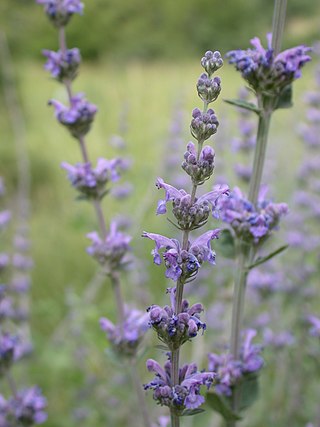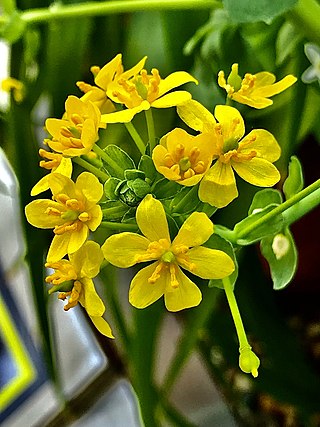In chemistry, an alkali is a basic, ionic salt of an alkali metal or an alkaline earth metal. An alkali can also be defined as a base that dissolves in water. A solution of a soluble base has a pH greater than 7.0. The adjective alkaline, and less often, alkalescent, is commonly used in English as a synonym for basic, especially for bases soluble in water. This broad use of the term is likely to have come about because alkalis were the first bases known to obey the Arrhenius definition of a base, and they are still among the most common bases.

Soap is a salt of a fatty acid used for cleaning and lubricating products as well as other applications. In a domestic setting, soaps, specifically "toilet soaps", are surfactants usually used for washing, bathing, and other types of housekeeping. In industrial settings, soaps are used as thickeners, components of some lubricants, emulsifiers, and catalysts.

Modern Hebrew, also called Israeli Hebrew or simply Hebrew, is the standard form of the Hebrew language spoken today. Developed as part of the revival of Hebrew in the late 19th and early 20th centuries, it is the official language of the State of Israel and the only Canaanite language still spoken as a native language. The revival of Hebrew predates the creation of the state of Israel, where it is now the national language. Modern Hebrew is often regarded as one of the most successful instances of language revitalization.

Maror are the bitter herbs eaten at the Passover Seder in keeping with the biblical commandment "with bitter herbs they shall eat it.". The Maror is one of the symbolic foods placed on the Passover Seder plate.

Calicotome spinosa, the thorny broom or spiny broom, is a very spiny, densely branched shrub of the family Fabaceae which can reach up to three metres in height. It grows in the Western Mediterranean region on sunny slopes and dry, rocky ground. It is found in Spain, France, Italy, Croatia, Morocco, Tunisia, Libya, Algeria and Turkey, and it has been introduced to New Zealand. From March to June it produces bright yellow flowers which are borne singly or in small clusters. The seed-pods are 30mm long and are almost hairless, unlike those of the similar species Calicotome villosa.

Barilla refers to several species of salt-tolerant (halophyte) plants that, until the 19th century, were the primary source of soda ash and hence of sodium carbonate. The word "barilla" was also used directly to refer to the soda ash obtained from plant sources. The word is an anglicization of the Spanish word barrilla for saltwort plants.

Atriplex halimus is a species of fodder shrub in the family Amaranthaceae.

A tabun oven, or simply tabun, is a portable clay oven, shaped like a truncated cone. While all were made with a top opening, which could be used as a small stove top, some were made with an opening at the bottom from which to stoke the fire. Built and used even before biblical times as the family, neighbourhood, or village oven, tabun ovens continue to be built and used in parts of the Middle East today.
Cimolian Earth, also known as "cimolite", refers to a variety of clays used widely in the ancient world. These clays were used in medicine, in bleaching, and in the washing of clothes. They appear to be similar to Fuller's earth, and to Kaolin. A variety of colours of Cimolian Earth was known.
Kil'ayim are the prohibitions in Jewish law which proscribe the planting of certain mixtures of seeds, grafting, the mixing of plants in vineyards, the crossbreeding of animals, the formation of a team in which different kinds of animals work together, and the mixing of wool with linen in garments.

Soda stocksii is a shrub species of the family Amaranthaceae.

Zohar Amar is a professor in the Department of Land of Israel Studies at the Bar-Ilan University, whose research specialties are: natural history in ancient times; the identification of the flora of the Land of Israel and identification of the fauna of the Land of Israel according to descriptions in classical Jewish sources; the material culture and realia of daily life in the Middle Ages as reflected in agriculture and commerce; the history of medicine and ethno-pharmacology. His research integrates diverse fields of knowledge, including branches of natural science, history, archaeology, linguistics, and Judaic studies.
The incense offering, a blend of aromatic substances that exhale perfume during combustion, usually consisting of spices and gums burnt as an act of worship, occupied a prominent position in the sacrificial legislation of the ancient Hebrews.

Calicotome villosa, also known as hairy thorny broom and spiny broom, is a small shrubby tree native to the Mediterranean region.
Muhammad ibn Sa'id al-Tamimi, , known by his kunya, "Abu Abdullah," but more commonly as Al-Tamimi, was a tenth-century physician, who came to renown on account of his medical works. Born in Jerusalem, Al-Tamimi spent his early years in and around Jerusalem where he studied medicine under the tutelage of two local physicians, Al-Hasan ibn Abi Nu'aym, and a Christian monk, Anba Zecharia ben Thawabah. Al-Tamimi possessed an uncommon knowledge of plants and their properties, such that his service in this field was highly coveted and brought him to serve as the personal physician of the Ikhshidid Governor of Ramla, al-Hassan bin Abdullah bin Tughj al-Mastouli, before being asked to render his services in Old Cairo, Egypt. Around 970, Al-Tamimi had settled in Fustat, Egypt, and there prospered in his medical field, writing a medical work for the vizier, Ya'qub ibn Killis (930–991), a Baghdadi Jew who came to work in Egypt under the auspices of the Fatimids. He specialized in compounding simple drugs and medicines, but is especially known for his having concocted a theriac reputed as a proven antidote in snakebite and other poisons, which he named tiryaq al-fārūq because of its exceptional qualities.

Nathan ben Abraham, known also by the epithet President of the Academy in the Land of Israel, was an 11th-century rabbi and exegete of the Mishnah who lived in Ramla, in the Jund Filastin district of the Fatimid Caliphate. He was the author of the first known commentary covering the entire Mishnah.

Nepeta curviflora, commonly known as Syrian catnip, is a herbaceous flowering plant native to the Middle East. It was first described in 1844.

Wild edible plants in the regions of Israel and Palestine have been used to sustain life in periods of scarcity and famine, or else simply used as a supplementary food source for additional nourishment and pleasure. The diverse flora of Israel and Palestine offers a wide range of plants suitable for human consumption, many of which have a long history of usage in the daily cuisines of its native peoples.

Delphinium peregrinum, also commonly known as violet larkspur, is a Eurasian flowering plant, belonging to the genus Delphinium, endemic to Turkey, the Eastern Mediterranean and Western Irano-Turanian region, bearing an erect, annual stem with glabrous compound leaves and reaching a height of 27–35 cm. The plant, which blossoms between April and August, bears five colorful sepals (calyx), petaloid, the posterior sepal spurred, the two lateral sepals and the two lower sepals without spurs; while the anterior sepals can either be fused or separated. The inflorescence (corollas) are sparsely arranged, irregular, and are borne on long pedicels subtended by bracts.

Leontice leontopetalum, commonly known as leontice, lion's foot, lion's turnip, and lion's leaf, is a perennial geophyte having a wide distribution, and growing primarily in semi-desert regions. The name "lion's foot" is derived from the Greek λεοντοπέταλη [= "lioness"] in reference to a fancied resemblance between the shape of the leaves and the pads of a lioness’s paw.
















